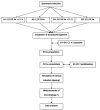Influence of Ceramic and Substrate Types on the Microleakage of Aged Porcelain Laminate Veneers
- PMID: 33732028
- PMCID: PMC7959209
- DOI: 10.2147/CCIDE.S280280
Influence of Ceramic and Substrate Types on the Microleakage of Aged Porcelain Laminate Veneers
Abstract
Objective: To evaluate the effects of the type of ceramic, and the influence of the type of cervical substrate on the microleakage of aged Porcelain laminate veneers (PLVs).
Materials and methods: A total of 48 sound human maxillary premolars were divided randomly into two groups (n=24), Group A: lithium disilicate PLVs; Group B: zirconia reinforced lithium silicate PLVs. The groups were further subdivided into four subgroups (n=12): (A1, B1): finishing line placed in Class V composite filling; (A2, B2): finishing line placed in sound enamel. In subgroups A1 and B1 standardized Class V cavities were prepared and restored with nanocomposite. Standardized PLVs tooth preparation was done for the specimens in all subgroups. Cementation of PLVs was done with a light cured resin cement and specimens were stored in distilled water for 2 weeks. Mechanical load cycling (45,000 cycle, 49 N at 2.5 Hz) and thermocycling procedure (500 cycles, 5-55°C) were done. A microleakage test was done with dye penetration (2% methylene blue) and the microleakage percentage was recorded and calculated using a stereomicroscope and ImageJ program.
Results: Means of microleakage percentage of the subgroups were: A1 (6.6075%), A2 (4.6058%), B1 (7.3158%), and B2 (6.105%), Two-way ANOVA showed a significant effect of ceramic type and cervical composite substrate. According to samples t-test, subgroup A2 was significantly lower than A1 and B2, while subgroup B2 was significantly lower than B1. A P-value≤0.05 was considered as statistically significant.
Conclusion: The type of ceramic and the type of substrate both affects PLV microleakage. Lithium disilicate PLVs had significantly lower microleakage compared to zirconia reinforced lithium silicate PLVs. Teeth with cervical composite substrate had a significantly higher microleakage compared to teeth with enamel substrate.
Keywords: IPS e.max CAD; VITA Suprinity; dental leakage; dental restoration; dental veneers.
© 2021 Alnakib and Alsaady.
Conflict of interest statement
The authors report no conflicts of interest in this work.
Figures





References
-
- Höland W, Apel E, Van‘t Hoen C, Rheinberger CS. Studies of crystal phase formations in high-strength lithium disilicate glass–ceramics. J Non Cryst Solids. 2006;352(38–39):4041–4050.
-
- Krüger S, Deubener J, Ritzberger C, Höland WJ. Nucleation kinetics of lithium metasilicate in Z r O 2‐bearing lithium disilicate glasses for dental application. Int J Appl Glass Sci. 2013;4(1):9–19.
LinkOut - more resources
Full Text Sources
Other Literature Sources
Miscellaneous

